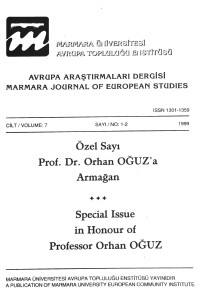Abstract
References
- Baumol, W.J. "Contestable markets: an uprising in the theory of industry structure", American Economic Review, Vol. 72, No.1, Mart 1982. s.1-15.
- Chamberlin, E. The Theory of Monopolistic Competition, Cambridge, Mass. : Harvard Universty Press. 1936.
- Dasgupta, A.K. Epochs of Economic Theory, New York: Basil Blackwell, 1985. Demsetz, H. "Industry structure, market rivalry, and public policy", Journal of Law and Economics, No.16, s.1-1 0.
- Frisch, R. "Monopoly-Polypoly-The Concept of Force in The Economy", International Economic Papers, No.1 , 1951, s.23-36.
- Grether, E.T., "Industrial Organizatin: Past History and Future Problems", American Economic Review, Vo1.60, No.2 (May1s 1970), s.83-89.
- Jacquemin, A. The New Industrial Organization, Oxford: Clarendon Press, 1987. Mason, E. S., Economic Concentration and The Monopol Problem, Cambridge,
- Mass.: Harvard University Press. 1957. 186 SERBEST PiYASA EKONOMiSi ve "iKTiSADi GUQ" Mickwitz,G. "The Means of Comptetion at Various Stages of Production and Distribution", Kyklos, Vol. 4 (1958), s. 509-521 .
- Pen, J. "Bilateral Monopoly, Bargaining and the Concept of Economic Power", Power in Economics, Ed. K.W. Rothschild, Baltimore: Penguin Books. Inc. 1971 , Phillips, A ve R.E. Stevenson, "The Historical Development of Industrial Organization," History of Political Economy, Vol: 6 (1974), s.324-342.
- Barlett, R., Economics and Power, Cambridge Univ. Pr., 1989, Cambridge. Robinson, J. "Imperfect Competition Reviseted", Economic Journal, Vol. 63, Mart 1953, s. 580-595.
- Robinson, J. The Economic of Imperfect Competition, (lkinci Bask1), London: Macmillan Co. Ltd. 1969.
- Rothschild, K.W. Power in Economics, Baltimore: Penguin Books, Inc. 1971. Shepherd, W.G. "'Contestability' vs. Competition", American Economic Review, Vol. 74, No. 4, Eyl011984, s. 572-87.
- Smith, A. The Wealth of Nations, Baltimore: Penguin Books, Inc. 1970. Sraffa, P. "The Law of Return Under Competitive Conditions", Economic Journal, Vol.36, (Aral1k 1926), s.535-550.
Abstract
Free market system in the Liberal Economic paradigm means that when each individual acts in his or her self-interest, the welfare of society is automatically assured. This is so called "invisible hand" of Adam Smith which insures the social welfare, even though individuals seek their own interests. In order to have such a system, one has to assume: 1- large number of firms which produce homegenous products, 2- free entry and exit in the markets. Yet, these assumptions also mean that there would be no "economic power" of any individual actors. The reason is obvious: the first assumption implies that no firm has any power to influence the market conditions in which it operates, the second, if any one of them got such power, it can not carry out too long because of competition which comes from new firms entering freely into the market. Therefore, in order to teorize an "ideal" economic system, the Liberal paradigm tries to exclude the "economic power" from the economic analyses and many unsettled discussions in today's economic issues are in someway related to this effort.
Keywords
References
- Baumol, W.J. "Contestable markets: an uprising in the theory of industry structure", American Economic Review, Vol. 72, No.1, Mart 1982. s.1-15.
- Chamberlin, E. The Theory of Monopolistic Competition, Cambridge, Mass. : Harvard Universty Press. 1936.
- Dasgupta, A.K. Epochs of Economic Theory, New York: Basil Blackwell, 1985. Demsetz, H. "Industry structure, market rivalry, and public policy", Journal of Law and Economics, No.16, s.1-1 0.
- Frisch, R. "Monopoly-Polypoly-The Concept of Force in The Economy", International Economic Papers, No.1 , 1951, s.23-36.
- Grether, E.T., "Industrial Organizatin: Past History and Future Problems", American Economic Review, Vo1.60, No.2 (May1s 1970), s.83-89.
- Jacquemin, A. The New Industrial Organization, Oxford: Clarendon Press, 1987. Mason, E. S., Economic Concentration and The Monopol Problem, Cambridge,
- Mass.: Harvard University Press. 1957. 186 SERBEST PiYASA EKONOMiSi ve "iKTiSADi GUQ" Mickwitz,G. "The Means of Comptetion at Various Stages of Production and Distribution", Kyklos, Vol. 4 (1958), s. 509-521 .
- Pen, J. "Bilateral Monopoly, Bargaining and the Concept of Economic Power", Power in Economics, Ed. K.W. Rothschild, Baltimore: Penguin Books. Inc. 1971 , Phillips, A ve R.E. Stevenson, "The Historical Development of Industrial Organization," History of Political Economy, Vol: 6 (1974), s.324-342.
- Barlett, R., Economics and Power, Cambridge Univ. Pr., 1989, Cambridge. Robinson, J. "Imperfect Competition Reviseted", Economic Journal, Vol. 63, Mart 1953, s. 580-595.
- Robinson, J. The Economic of Imperfect Competition, (lkinci Bask1), London: Macmillan Co. Ltd. 1969.
- Rothschild, K.W. Power in Economics, Baltimore: Penguin Books, Inc. 1971. Shepherd, W.G. "'Contestability' vs. Competition", American Economic Review, Vol. 74, No. 4, Eyl011984, s. 572-87.
- Smith, A. The Wealth of Nations, Baltimore: Penguin Books, Inc. 1970. Sraffa, P. "The Law of Return Under Competitive Conditions", Economic Journal, Vol.36, (Aral1k 1926), s.535-550.
Details
| Primary Language | Turkish |
|---|---|
| Journal Section | Makaleler |
| Authors | |
| Publication Date | December 25, 1999 |
| Published in Issue | Year 1999 Volume: 7 Issue: 1&2 |

